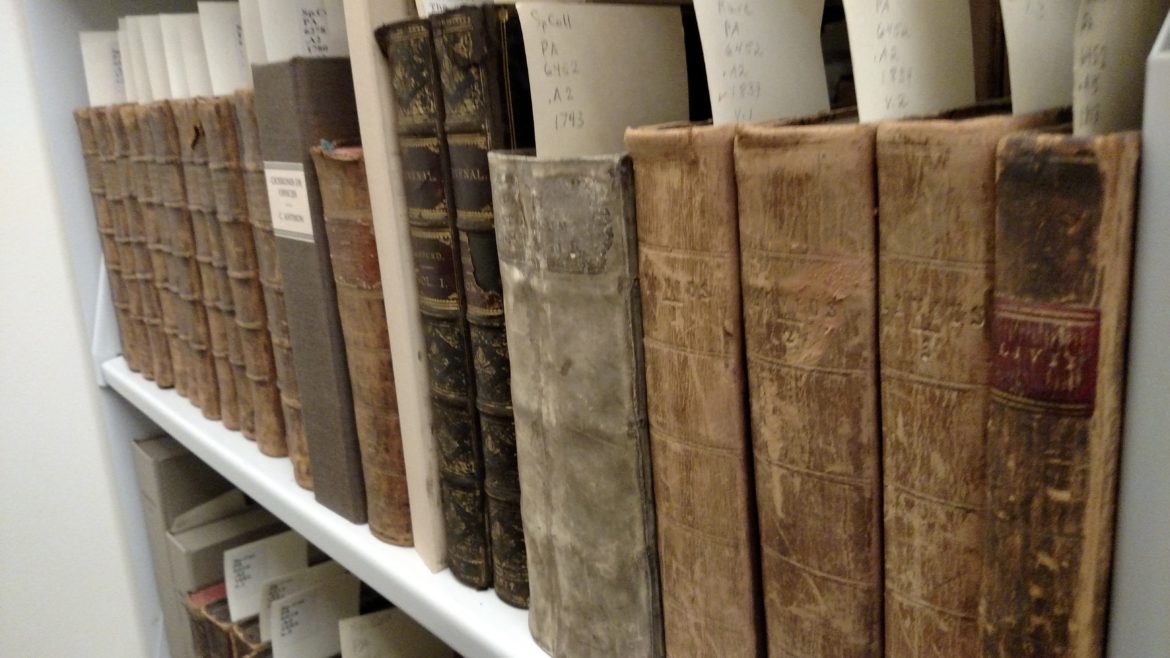
View of the PA Rare Books shelf, Special Collections Research Center, George Mason University Libraries
When researching with rare books, it is important to remember that rare books contain so much more information than just the words found on the page!
In the General Collections, the focus of a book is usually the text and the information contained therein. While this continues to be an important aspect of researching with a rare book, in Special Collections researchers can also glean additional, important information from the physical structure of the book. How was the book constructed? Does it the book contain its original binding? Does the book have a later historical binding? These questions (and others!) can reveal additional areas of inquiry and research.

Diagram of the parts of a medieval book binding, by Jane Greenfield, from Catalogue of Medieval and Renaissance Manuscripts in the Beinecke Rare Book and Manuscript Library, Yale University, Volume 1: MSS 1-250, by Barbara Shailor
When discussing historical bindings, the Rare Books stacks of the Special Collections Research Center are filled with examples of book bindings from different periods of history. Highlighted here are two of my favorite bindings in the Special Collections Research Center stacks.
- Euclid’s Elements, QA3 .S8708 1627

Limp vellum binding on the 1627 edition of Euclid’s Elements, QA3 .S8708 1627
With beautiful mathematical diagrams, the inside of this 1627 edition of Euclid’s Elementorum is stunning. But the binding can tell the researcher much about its user, too! It is a small, hand held volume, with a limp vellum binding. Limp vellum bindings are a flexible vellum (calfskin) covering. These bindings were the inexpensive bookbinding choice of the day, the equivalent of the paperback.
- Henry Baker, Employment for the Microscope: In Two Parts, QH271 .B32 1764

Baker, Emloyment of the Microscope, spine and cover
In 1764, the second edition of Employment for the Microscope was published. Filled with pasted in inserts of scientific equipment and many fold out diagrams, this book is fascinating for many reasons.
This binding is a three quarter binding, so called because the proportion or spine/corner material to side materials is 3:1. In three quarters binding, the large spine and corner areas are covered in one material (in this case, leather), while the rest of the cover is covered with either cloth or paper (in this case, cloth).
But what makes this book standout is its marbled foreedge.
Marbling is a water surface design and its swirling patterns are produced by floating color on the surface of water, which is then carefully transferred to either paper or cloth.
In this case, the marbled foreedge is in beautiful blues.

Marbled foreedge of Baker’s Employment of the Microscope
To search the collections held at Special Collections Research Center, go to our website and browse the finding aids by subject or title, search the Mason catalog and limit the search to Fenwick – Special Collections. You may also e-mail us at speccoll@gmu.edu or call 703-993-2220 if you would like to schedule an appointment, request materials, or if you have questions. Appointments are not necessary to request and view collections.

